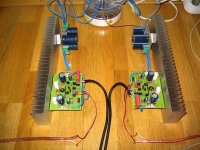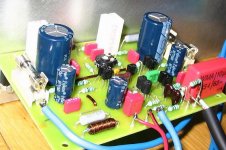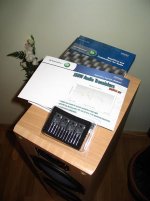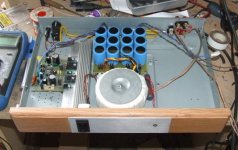roender, you're right, the mje15034/35 looks really superior ! The 2 amperes are unlikely to be ever reached.
The voltage across the 33ohm will always be ~1.2v, no smoke here !
Assuming "worst" case, 36v into 4ohm, current will be ~9amperes, hfe for mjl3281 drops to maybe 80. This gives base current of 112ma, far from 2A.
Mike
The voltage across the 33ohm will always be ~1.2v, no smoke here !
Assuming "worst" case, 36v into 4ohm, current will be ~9amperes, hfe for mjl3281 drops to maybe 80. This gives base current of 112ma, far from 2A.
Mike
Maybe the wining pairs will be mje15034-mjl0281A for NPN and mje15035-mjl0302A for PNP
Mike, please tell me more about JFETS on input diff amp. How much better sonically are compared with MPSA18?
Best regards,
Mihai
Mike, please tell me more about JFETS on input diff amp. How much better sonically are compared with MPSA18?
Best regards,
Mihai
The jfets sound sweeter/more relaxed. The difference is not very big, but big enough to be perceived without A/B comparison.
The perceived difference between different choice of output devices is bigger.
Mike
The perceived difference between different choice of output devices is bigger.
Mike
What about 10-22 ohm degeneration resistors in MPSA18 emitters?
Theoretically it should "sound" better than jfets. Practically, I dont know :-(
Theoretically it should "sound" better than jfets. Practically, I dont know :-(
Practically, it sounds worse...  Okay, 10ohms are not audible.
Okay, 10ohms are not audible.
The better sound from the jfets is not because of lowered feedback.
Mike
 Okay, 10ohms are not audible.
Okay, 10ohms are not audible.The better sound from the jfets is not because of lowered feedback.
Mike
JFETs and MOSFETs are less sensitive to HF products rectification and mix, that's all and simple. Try small MOSFETs, they sound even better than JFETs (but you do not care, still bound by engineering prejudice).
jacco vermeulen said:
Why, Pavel ?
Who knows? Our experience when compared 3 types of input devices. Maybe transfer characteristic /RF-HF again/??
Pardon me being a very unexperienced person. But I believe that this may be because of the high input impedance of MOSFET's. Since there is so much resistance between the gate and drain (or source), maybe there is less of a short of the former components through the gate and drain (or source), meaning that less of the noise generated from the former components goes through the gate and more through the RF filter capacitors? I don't know much if anything about filters, so I'm not sure if the ability/frequency of an RC filter increases or decreases with resistance.
Also, I remember seeing a gate voltage-source (or drain) current graph for a MOSFET in as book and it was a constant curve. Could this sweeter/more relaxed sound be caused by distortion?
Again, pardon me for my lack of experience, but I wanted to know how well I could try to understand things off the top of my head.
sorry if this post is just in the way...
Also, I remember seeing a gate voltage-source (or drain) current graph for a MOSFET in as book and it was a constant curve. Could this sweeter/more relaxed sound be caused by distortion?
Again, pardon me for my lack of experience, but I wanted to know how well I could try to understand things off the top of my head.
sorry if this post is just in the way...
I consulted on this with John Westlake and he suggested that spread gate insulating resistance forms something like a series of RC filters.
Replace by mosfets isn't simply - they must be carefully selected and exist great differences between manufacturers, although they have the same marking....
Hi Upupa,
Yes, I've noticed that in servicing amplifiers. I am much more comfortable with J Fets for that reason.
There must be a solid reason why most manufacturers use either BJT's or J Fets. Production manufacturing would require devices that are very similar and time wasted hand matching with low yield could not be tolerated. Similarly, hobbyists can not afford to buy mass quantities for a few pairs.
We should move this discussion to the new thread. These topics will get lost in this thread.
-Chris
Yes, I've noticed that in servicing amplifiers. I am much more comfortable with J Fets for that reason.
There must be a solid reason why most manufacturers use either BJT's or J Fets. Production manufacturing would require devices that are very similar and time wasted hand matching with low yield could not be tolerated. Similarly, hobbyists can not afford to buy mass quantities for a few pairs.
We should move this discussion to the new thread. These topics will get lost in this thread.
-Chris
Hello all,
This is my mirrored symasym. The music that come out from a peer of Monitor Audio B4 is lovely, warm and soft. It is the best amplifier that I have made so far.
Thank you very much Mike, Pavel and all of you who actively participate at this marvelous project (I don't forgotten you Jacco, thank you too sir)
I succeed to obtain -0.3...+0.4mv offset, matching k170-bl JFETs in less than 0.5% D-S current. The same peers of two symasym amplifiers, with MPSA18 in input diff amp, have -3.5...-4mv offset (hfe matched in less than 1%).
I have MJE15034/35 as drivers and MJW0281/0302 as a finals. The iq is set at 113mA. In fact, I don't perceive any difference in sound between 10...300mA iq but I like 113 number 🙂
This is my mirrored symasym. The music that come out from a peer of Monitor Audio B4 is lovely, warm and soft. It is the best amplifier that I have made so far.
Thank you very much Mike, Pavel and all of you who actively participate at this marvelous project (I don't forgotten you Jacco, thank you too sir)
I succeed to obtain -0.3...+0.4mv offset, matching k170-bl JFETs in less than 0.5% D-S current. The same peers of two symasym amplifiers, with MPSA18 in input diff amp, have -3.5...-4mv offset (hfe matched in less than 1%).
I have MJE15034/35 as drivers and MJW0281/0302 as a finals. The iq is set at 113mA. In fact, I don't perceive any difference in sound between 10...300mA iq but I like 113 number 🙂
Attachments
Pinkmouse
I don't think this one is mirrored, is it?
It does look nice, congratulations, some day I'll make one as nice
as this one.
Oh my, where are my skilled abilities?
I don't think this one is mirrored, is it?
It does look nice, congratulations, some day I'll make one as nice
as this one.
Oh my, where are my skilled abilities?
Hi John, only Roender's and yours are mirrored. 🙂
Roender, Al, nice to see new babys born !
Roender, why not 66.6ma bias ? 😀 I am curious about that OnSemi package, what is that ? It does not seem to be a standard sample delivery.
Al, impressive PSU ! What size are these caps ? Diodes, MUR820 ?
Mike
Roender, Al, nice to see new babys born !
Roender, why not 66.6ma bias ? 😀 I am curious about that OnSemi package, what is that ? It does not seem to be a standard sample delivery.
Al, impressive PSU ! What size are these caps ? Diodes, MUR820 ?
Mike
- Home
- Amplifiers
- Solid State
- Explendid amplifier designed by Michael Bittner, our MikeB




